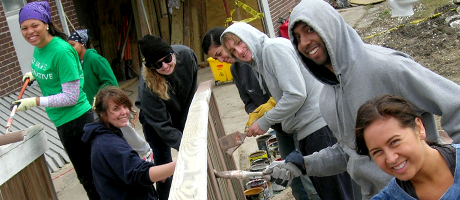More than 200 GW students spent the last week of their winter break, Jan. 3 - 10, volunteering in seven locations. This represents a large increase over last year, when 36 students traveled to New Orleans and Belize on Alternative Winter Break.
“The program serves a gateway for students to continue engaging in community service during their tenure at GW and beyond,” says Shannon Donahue, freshmen service coordinator and a master’s degree candidate in clinical mental health counseling.
Student volunteers built houses and schools, painted walls, assembled beds and worked with orphans and the Lost Boys Foundation, which assists Sudanese refugees, in Atlanta; Cusco, Peru; Duran, Ecuador; Galveston, Texas; Nashville, Tenn.; New Orleans; and San Juan Comalapa, Guatemala.
“I, like most GW students, become so wrapped up in academics and professional pursuits during the academic year that it’s difficult to put the time into community service that I should,” says Jacqueline Elizabeth Hackett, a Presidential Administrative Fellow in GW’s Center for Civic Engagement and Public Service and a learning partner on the New Orleans trip.
“The opportunity to give part of my winter break to service was so appealing to me because I could focus on giving back,” says Ms. Hackett, a master’s candidate in public policy at the Trachtenberg School of Public Policy and Public Administration. “Volunteering was my priority during this time without classes or internships.”
“I don’t think there is a better way to spend 10 days than traveling to another country with 27 people from GW of all ages, who can really teach you a lot,” says Elizabeth Lisowski, a junior studying international affairs who was a co-leader of the trip to Peru.
Ms. Lisowski went on GW’s trip to Belize last year with fellow GW student Derek Rogers and knew she wanted to go back. “Doing service work in the developing world provides a new perspective,” she says. “It’s very important to give back to your own country, but it is also important to give back to developing countries.”
The group that traveled to Peru – which included students, a Spanish professor and a staff member –plastered the adobe walls at the Chinchaysuyo Community Center and a school outside of Cusco. The group often had to wait for fresh water to arrive, and due to a lack of building materials, it was often necessary to improvise.
“We were cutting bamboo from the jungle and nailing it to the windows so the plaster had something to apply to,” she says. “Two-by-fours would have been easier, but they didn’t have the materials.”
The group had to raise $44,000 for the trip. “We did everything from selling Krispy Kreme donuts to hosting a party at Vineyard Vines and donating a portion to the cause to bake sales,” says Ms. Lisowski. “It’d be freezing cold outside, and we were there selling.”
According to Ms. Donahue, the program needed to raise $150,000 for all of the trips, and it has nearly met its goal.
“I chose to be a leader and volunteer on the trip to Nashville so that I could not only share my passion of volunteering to aid refugees in their resettlement process into the United States, but also inspire other GW students to give back,” says Merrill Calotta, a junior studying English and sociology.
Ms. Calotta and her group assisted a resettlement agency in Nashville called World Relief by helping a refugee family move into its new apartment. The group also worked at the Sudanese Women’s Services and Community Center teaching English to refugees and immigrants.
“One day, the ESL teacher did not show up, so our group was able to step in and provide five private tutors from GW to teach five refugees their English class for the day,” she says.
Divya Chalikonda, a sophomore and one of the leaders of the New Orleans trip, was most impressed by the opportunity to interact with the New Orleans residents, particularly an older man from the Upper Ninth Ward, whose house was being built by Habitat for Humanity.
“He came by and brought gumbo to all of us in thanks for our service to his community. He served it from the back of his pickup truck and kept it warm on a propane heater,” wrote Ms. Chalikonda in an e-mail. “He said before the flood he would go catch fish and his wife would take his catch and make gumbo and they would sell it out of the back of the truck as a means of income. The fact that this family would spend time to give back to us was touching.”
Comments? Criticism? The conversation continues. We welcome reactions, commentary and story recommendations on our Facebook page.


